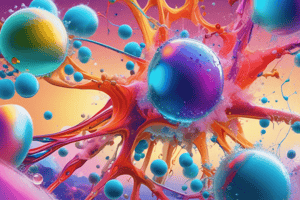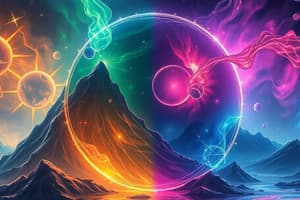Podcast
Questions and Answers
What process converts solid directly into gas?
What process converts solid directly into gas?
- Deposition
- Recombination
- Ionization
- Sublimation (correct)
What is an example of deposition?
What is an example of deposition?
- Dry ice
- Liquid water
- Naphthalene balls
- Water vapor freezing into ice (correct)
A pure substance can be separated via physical means.
A pure substance can be separated via physical means.
False (B)
Define an element.
Define an element.
What is the most abundant state of matter in the universe?
What is the most abundant state of matter in the universe?
Match the following properties with their classification:
Match the following properties with their classification:
What does the Law of Conservation of Mass state?
What does the Law of Conservation of Mass state?
The phase change from gas to solid is called ______.
The phase change from gas to solid is called ______.
The resistance to flow is referred to as ______.
The resistance to flow is referred to as ______.
Flashcards are hidden until you start studying
Study Notes
### Matter
- Matter has mass and volume
- Matter exists in four states: Solid, Liquid, Gas, and Plasma
- Plasma is the most abundant state of matter in the universe
- Plasma exists as a free, ionized gas that greatly responds to magnetic fields.
### States of Matter
- Solids have definite shape and volume, and their molecules vibrate in place
- Liquids have indefinite shape, but definite volume, and their molecules glide over each other
- Gases have indefinite shape and volume, and their molecules move randomly
- Plasma, the fourth state of matter, has free ions and electrons.
### Phase Changes
- Sublimation: Solid to gas (example: Naphthalene balls)
- Deposition: Gas to solid (example: Dry ice/cardice)
- Recombination/Deionization: Plasma to gas
- Ionization: Gas to plasma
### Matter Classification
- Pure substances are the simplest form of matter
- Elements are the simplest form of a substance
- Compounds are formed when two or more chemicals combine chemically
- Mixtures contain two or more substances physically combined.
- Homogeneous mixtures have one phase, like solutions.
- Heterogeneous mixtures have two phases, like suspensions and colloids (e.g., milk).
### Dependence to the Amount of Matter
- Extrinsic properties depend on the amount of matter present, such as length, mass, volume, pressure, entropy, enthalpy, and electrical resistance.
- Intrinsic properties do not depend on the amount of matter present, such as density, specific gravity, viscosity, velocity, temperature, and color.
### Fundamental Chemistry Laws
- Law of Conservation of Mass or Matter (Antoine Lavoiser): Mass is neither created nor destroyed.
Studying That Suits You
Use AI to generate personalized quizzes and flashcards to suit your learning preferences.




